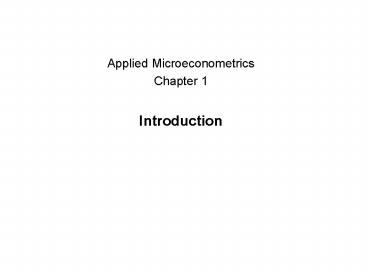Applied Microeconometrics Chapter 1 Introduction PowerPoint PPT Presentation
1 / 11
Title: Applied Microeconometrics Chapter 1 Introduction
1
Applied MicroeconometricsChapter
1Introduction
2
Definition of microeconometrics
- Econometric analysis of individual-level
(disaggregate) data - firms / establishments
- households / individuals
- although many techniques of microeconometrics
can also be applied with grouped data - Microeconometrics is used to estimate relations
derived from hypotheses on individual behaviour
3
Definition of microeconometrics
- Individual decisions are inherently discrete,
while the corresponding aggregates are smooth - choices may be discrete (e.g., modes of
transport) - in a given observation period, the individual may
not participate in the activity - observed variables have limited ranges of
variation - examples labour supply, consumer demand for
particular goods - Hence, individual-level data often imply a
deviation from linearity
4
Example the voting decision
- Choice variable voting yes-no
- Explanatory variable household income
- Nonlinear estimation (e.g. by maximum likelihood)
is more appropriate than OLS
y
OLS (linear)
1
x x x x x x
0
x x x x x x
x
5
Advantages of microeconometrics
- Greater information content
- A typical survey contains information on 1000s
of households - Compare this to the typical time series with
40-50 data points inference will be much more
robust - But high information content means that
individual-level data exhibit a large degree of
variation - They require an appropriate way to deal with
individual heterogeneity - Lack of aggregation bias
6
Some reasons for aggregation bias
- In the example of product demand, not all goods
are bought by all consumers - Estimating a demand model on aggregate date
implies the assumption of a representative
consumer buying some of all goods - In this context, price or income elasticities
estimated from aggregate data correspond to
fundamental microeconomic parameters only under
very stringent assumptions - Similar example wage elasticity of labour supply
7
Course outline
- Introduction
- Models with binary dependent variables
- Ordered and multinomial models
- Models with limited dependent variables
- Selectivity models
- Programme evaluation
- Duration models
- Panel data models
8
- Main textbooks
- Cameron, A.C. and Trivedi, P.K. (2005).
Microeconometrics Methods and Applications,
Cambridge University Press. - Wooldridge, J.M. (2002). Econometric Analysis of
Cross Sectional and Panel Data, MIT Press. - Still useful
- Ronning, G. (1991), Mikroökonometrie, Springer
Verlag. - Maddala, G.S. (1983), Limited-dependent and
Qualitative Variables, Cambridge University Press - Specific references will be provided in each
chapter
Some general econometrics textbooks contain
chapters on microeconometric techniques, such
as Greene, W.H. (2008), Econometric Analysis, 6th
edition, Prentice Hall.
9
Common sources for microeconomic data
- Survey data
- household panels (e.g. SOEP)
- firm or establishment surveys (e.g.,
IAB-Betriebspanel) - Census data
- e.g., Mikrozensus, US Population Census
- Administrative data
- public use files, scientific use files, e.g.
Beschäftigtenstichprobe des IAB (IABS) - non-anonymised data (e.g. Beschäftigtenstatistik)
10
Types of data used for microeconometrics
- Cross-sectional data
- Individuals are sampled once at a particular
point of time t1 - Repeated cross-sections
- Sampling is repeated over several points of time
t1, t2, , but different units are sampled each
time - Longitudinal data
- Sampling occurs once at time t1 and the same
units are interviewed at subsequent points of
time t2, t3, - Main advantages of longitudinal data (1)
unobserved heterogeneity may be accounted for (2)
they allow for the estimation of dynamic
relationships
11
Some common problems with microeconomic data
- Biased sampling
- Response-based sampling (e.g., interview among
commuters using conducted on the train) - Survey non-response
- Sample attrition
- Length bias (short durations are under-sampled)
- Missing data or mismeasurement
- Item non-response
- Imperfect recall, deliberate misreporting,
misinterpretation of questionnaire, carelessness

